We pick up the trail on the second of my Japan Winter Wildlife Tours for 2019 today, as we continue to photograph the clumsily beautiful Whooper Swans at Lake Kussharo.
My final selection of images from this incredibly productive tour is still slightly over 300, so I have a little more work to do there, but I’ve been able to reduce the number of images to share with you today to a final twelve, so we’ll finish this series covering this year’s Japan winter tours with this episode.
Swan Fly-By at Dawn
The morning after our first
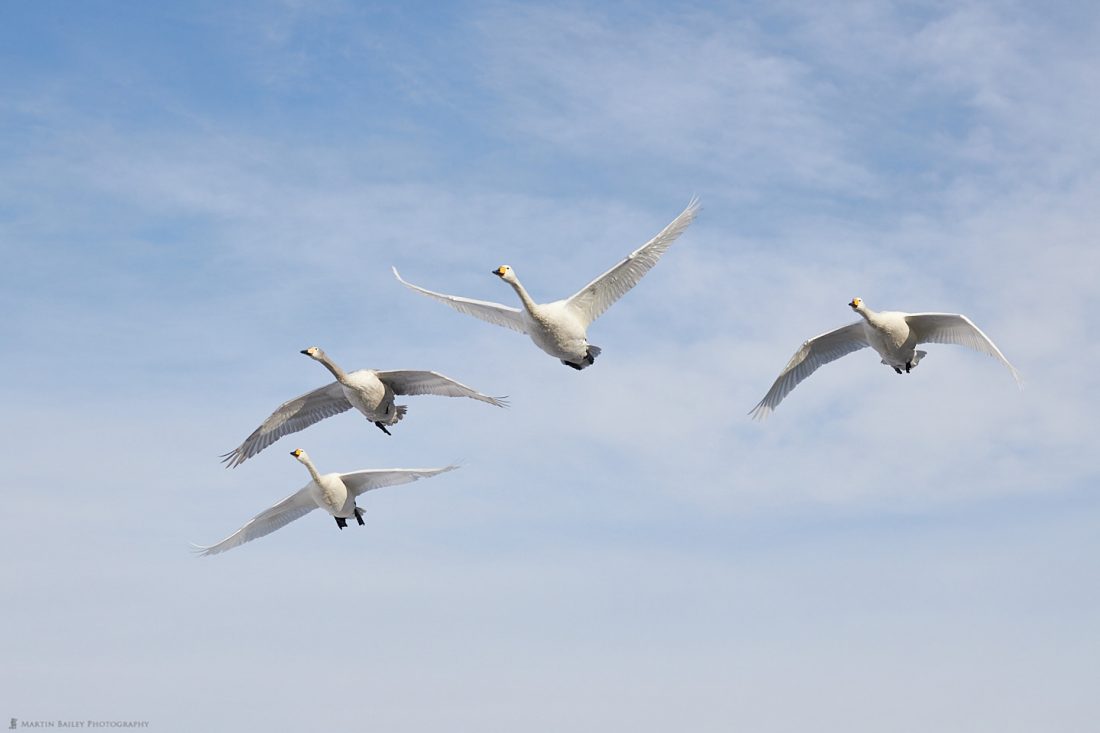
I really do enjoy watching these huge birds fly overhead, and when they are this close, I literally shot this with my 100-400mm lens wide open at 100mm, you can often hear the
Three Swan Pan
At the end of this day, we were back at the lake for another panning session, and I was again trying to get more than one swan in the

These panning shots are a lot of fun, and generally, we leave this location with lots of smiling faces, and that’s always good to see from my perspective. The hit ratio with this kind of shot is pretty low, but having two evenings to try it really helps too. My settings for this image where ISO 1000 for a 1/50 of a second at f/16, and I was out at 100 mm still with my 100-400mm lens. Although the lake was uncommonly not frozen on the first trip three weeks before this, as you can see in this image, it had mostly from over by the time we arrived on this trip.
Sulfur Mountain
The following morning we revisited the lake one last time, before continuing our journey to our last major destination of Rausu, for the sea eagles. On the way, our first stop was just 15 minutes from where we’d stayed, at Sulfur Mountain. You can see where it gets its name from with the yellow sulfur stained fumaroles in this somewhat apocalyptic looking photograph from our brief stop.
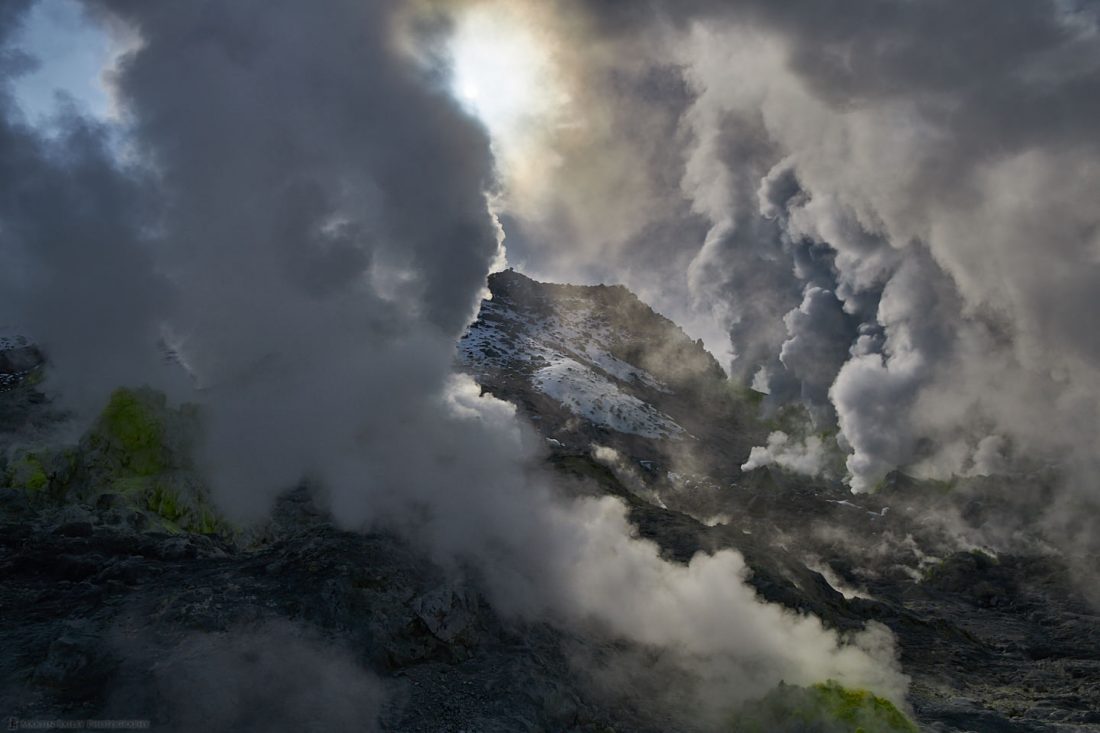
The steam from the fumaroles was really heavy on this day, but the breaks in the cloud and clear sky made for a really dramatic looking scene if you time the shot just right. I was exposing this so that the sun was almost completely over-exposed, and that of course made the shadows very dark, but the Shadows slider in Capture One Pro helped to bring that detail back out, so overall I’m happy with the results. My settings were 1/1250 of a second at ISO 100, at f/16, and my focal length was 35 mm, with Canon’s new RF 24-105mm f/4 lens.
Northern Red Fox
We also made our regular first stop at the Notsuke Peninsula during our drive and were greeted by this beautiful Northern Red Fox that posed for us on the snow for quite a while. To avoid frightening the foxes, we generally photograph them from the bus, and just open the windows, and of course, turn the engine off to stop the vibration.
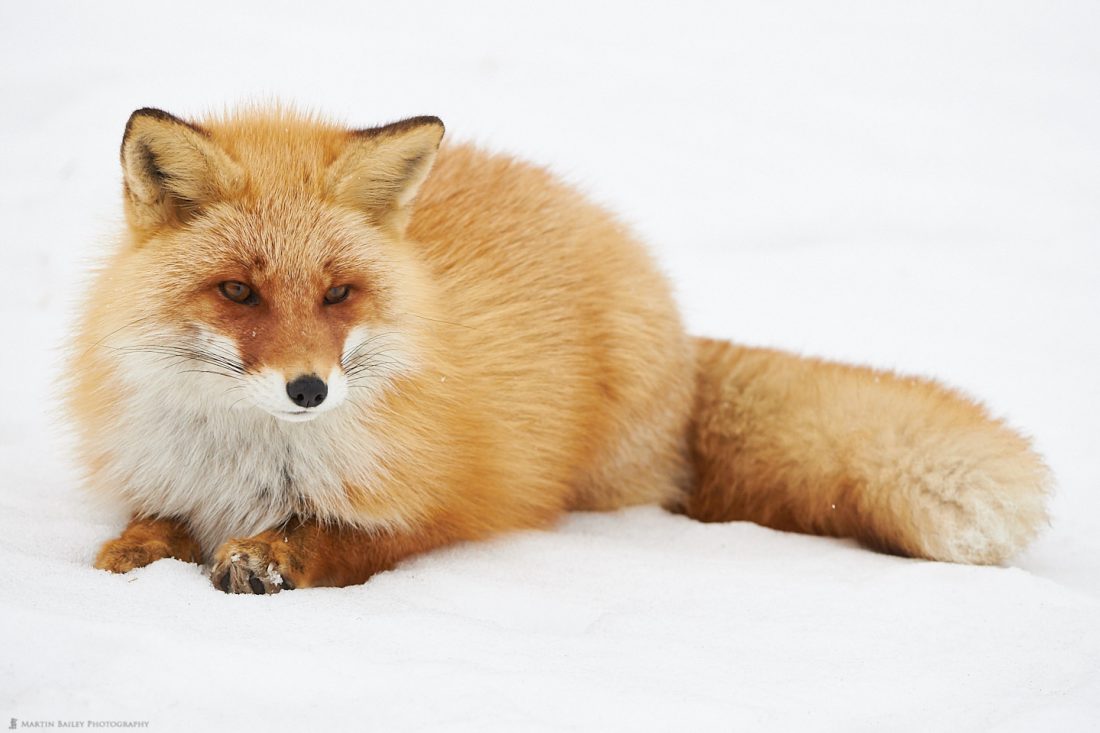
Occasionally we see foxes on the peninsula with tails that are stripped of their fur, probably by the sea eagles or crows that sometimes bully them, but this fox has probably one of the most beautiful bushy tails that I’ve seen. I shot a number of images of him sitting up, zoomed in on his face, but the images felt somewhat empty without that tail, so I settled for this image. My settings for this shot were ISO 1250 for an 1/800 of a second at f/8. I was using my 200-400mm lens with the built-in Extender engaged, and zoomed to 420 mm.
Sleepy Fox
Happy with our first encounter, I was surprised to get another fox shortly afterwards in a completely different environment, but every bit as cute as the first. This guy was quite a way off, so I had to shoot this with an external 2X Extender fitted as well as my 200-400mm lens with the internal Extender, for a focal length of 1065 mm, but as I’ve mentioned, the EOS R seems to quite like this combination, so I’m finding it very workable.

This fox was actually licking its paws then cleaning its face with them, but I’ve called this image Sleepy Fox as it almost looks like he’s got his head on his paws getting ready for a nice sleep. Because the light was relatively low, I was at ISO 5000 for this shot, for
Stags’ Play-Fighting
After a visit to the nature center, we turned our bus around and drove back down the Notsuke Peninsula, stopping this time for some Ezo Deer stags that were sizing up each others’ antlers. I like the flakes of snow in this, and the environment is beautiful, with the stags on the frozen brackish lake, just past the vegetation that they often feed on.
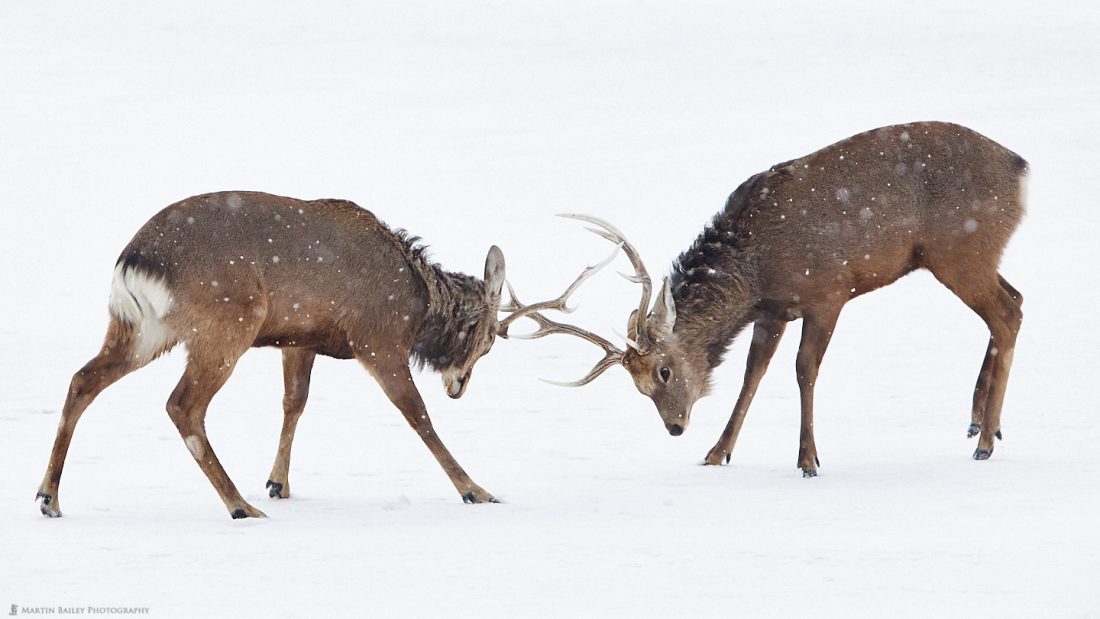
Having said that, the lake is like a white sheet, so I’ve cropped this down to a 16:9 aspect ratio image, removing the top a little, as it wasn’t really adding anything. You can see from the angle of the right deer’s feet that they weren’t really pushing at each other here, but it’s nice to see them at least starting to get ready for this year’s rutting season. It seems I still had my 2X Extender fitted for this image, as my focal length was 685 mm, and my ISO was up at 6400 with a shutter speed of 1/500 of a second at f/11.
Steller’s Sea Eagle at ISO 12800
As I often say, with the camera’s we have these days, cranking up the ISO is really not that big a deal any more, as long as you ensure that you are exposing to the right, as in, adjusting your exposure so that the right-most data of your image is almost touching the right shoulder of the histogram. I was doing just that at dawn the following day, as we started the first of our three trips out on a boat to photograph the sea eagles.

This was around 30 minutes before the sun actually came up over the Kuril Islands, so even with a 1/200 of a second shutter speed at f/5, I still needed my ISO at 12800 to get this shot, but as you can see, there really isn’t a lot of grain in this image, even in the dark bird, simply because I increased my ISO enough to get my image data over close to the right shoulder of the histogram. Had I been too scared to do that, and left it at say ISO 3200, I guarantee you, the image would have been much noisier.
The Humble Butt Shot
Another thing that you will often hear when shooting with other photographers is people lowering their cameras as a bird or animal turns away from us, calling out the image as a “butt shot”. I do this myself too, so I’m not calling anyone out with this, but I do want to point out that I feel it’s a crying shame to completely rule out an image based on a popular idea that a certain type of photograph is in some way taboo.
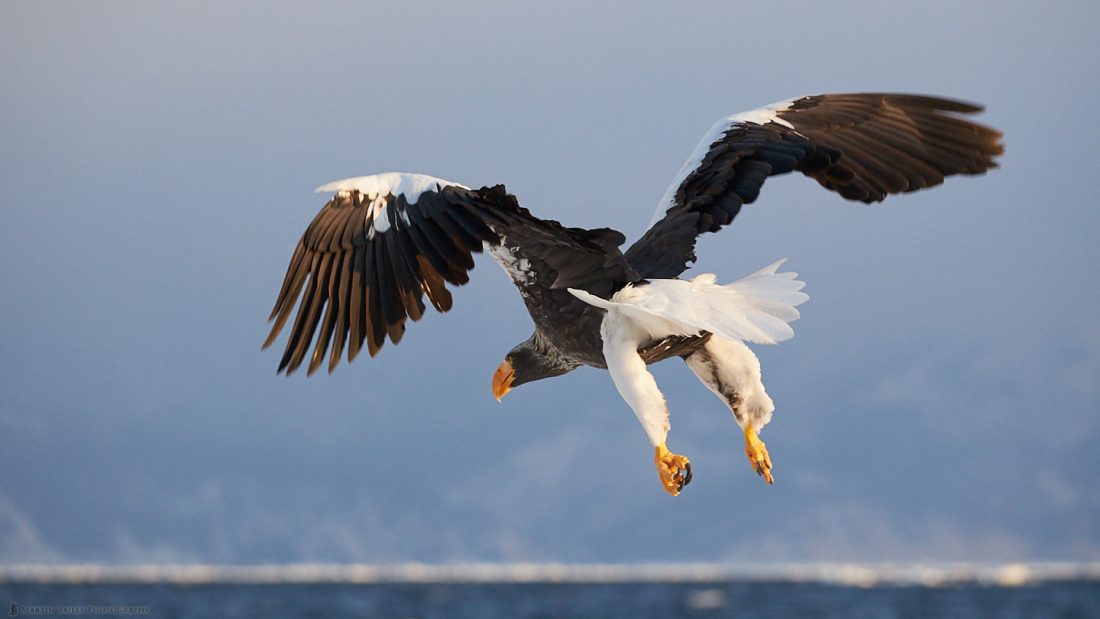
This shot of a Steller’s Sea Eagle is, I have to tell you, one of my favorite shots from this trip. I love the detail in the tail feathers and indeed the entire bird, and it doesn’t bother me one bit that this is a butt shot. Another thing that you’ll often hear bird photographers talking about is getting completely sharp wings, and this also is something that I purposefully do not try to do all the time. I like to use a shutter speed of around 1/1000 of a second, because it sometimes allows the wings to blur slightly, adding, in my opinion, some dynamism to the photograph.
I shot this with a shutter speed of 1/1250 of a second, and still have movement in the wing tips, but I like that here, so I’m happy with my choice of settings. My ISO was at 1600 by this time, as there was now much more light, and my aperture was down at f/10, with a focal length of 400mm.
Steller’s Sea Eagle and Sea Ice
Of course, shots from the front are great too, like in this next image. Quite often with birds, we end up with our shots being from the side, which are also nice, but because it’s less common to get a bird coming straight towards you, it is nice to get some shots like this.
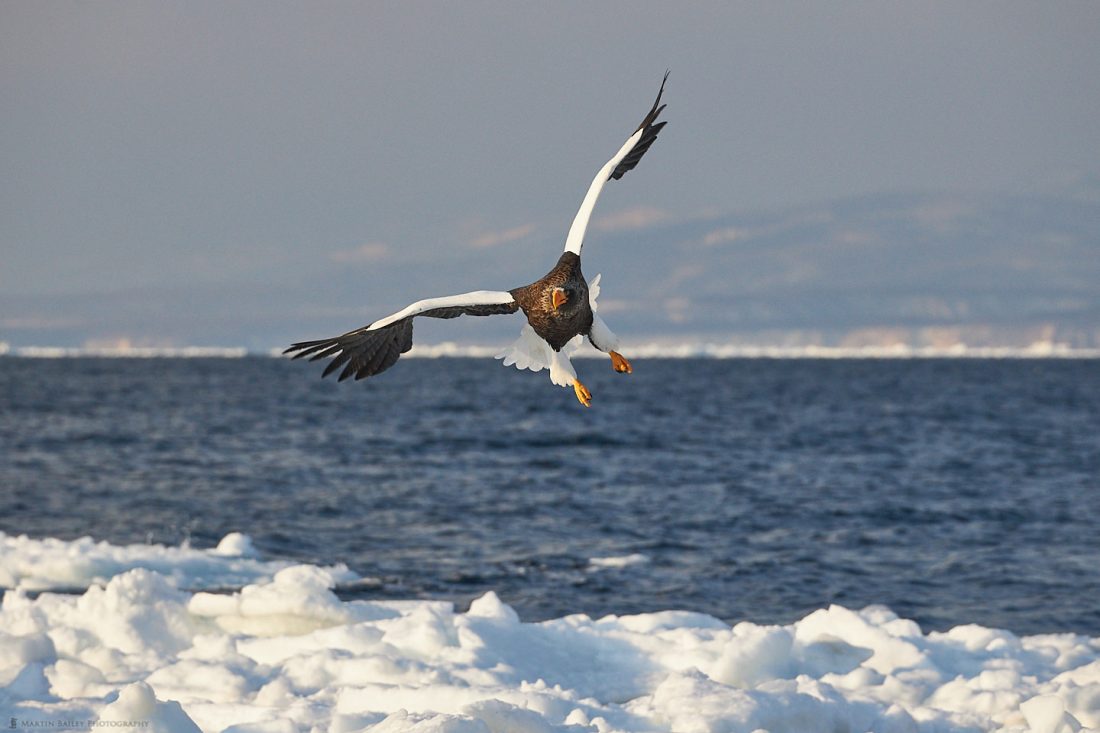
As you can see from these shots, we did also get a decent amount of sea ice on this second trip. The timing of the second trip does give us a better chance of getting sea ice, although I really don’t mind when we don’t get any. Since talking the skipper of the boat into going out even when there is no ice, around five years or more ago, it has become one of my favorite ways to photograph the eagles. When the ice is there though, it does add a nice additional element. My settings for this shot were ISO 1000 at 1/1600 of a second at f/10 and a focal length of 400 mm.
Steller’s Sea Eagle Silhouette
We went back down the Notsuke Peninsula once more on our second day in Rausu, but the photos weren’t great, so we’ll skip to the following morning, back out on the boat, as the sun rose above the Kuril Islands. I like to keep my eye out for an eagle flying close to the sun at this time, hoping for shots like this one, where the eagle is almost silhouetted against the sun’s disk.

To enable me to get this sort of image, this is one of the few times when I use Auto-ISO, and allow the camera to control the exposure itself. That way when I’m shooting away from the sun the ISO shifts to give me a brighter bird, but then when the sun is in the frame, like this, the ISO drops automatically, giving me a silhouette. The other settings I did set manually, which were
Steller’s Sea Eagle’s Grimace
Another shot that I’m happy with from a few minutes later, while the sun was still pretty low in the sky, is this one, of a Steller’s Sea Eagle, probably landing, kicking up snow and ice, but with his wings still open, as though he’s about to take off. The three eagles in this shot are obviously quite dark, because I’m shooting into the sun, but I love this angle and the sense of movement in this majestic raptor.
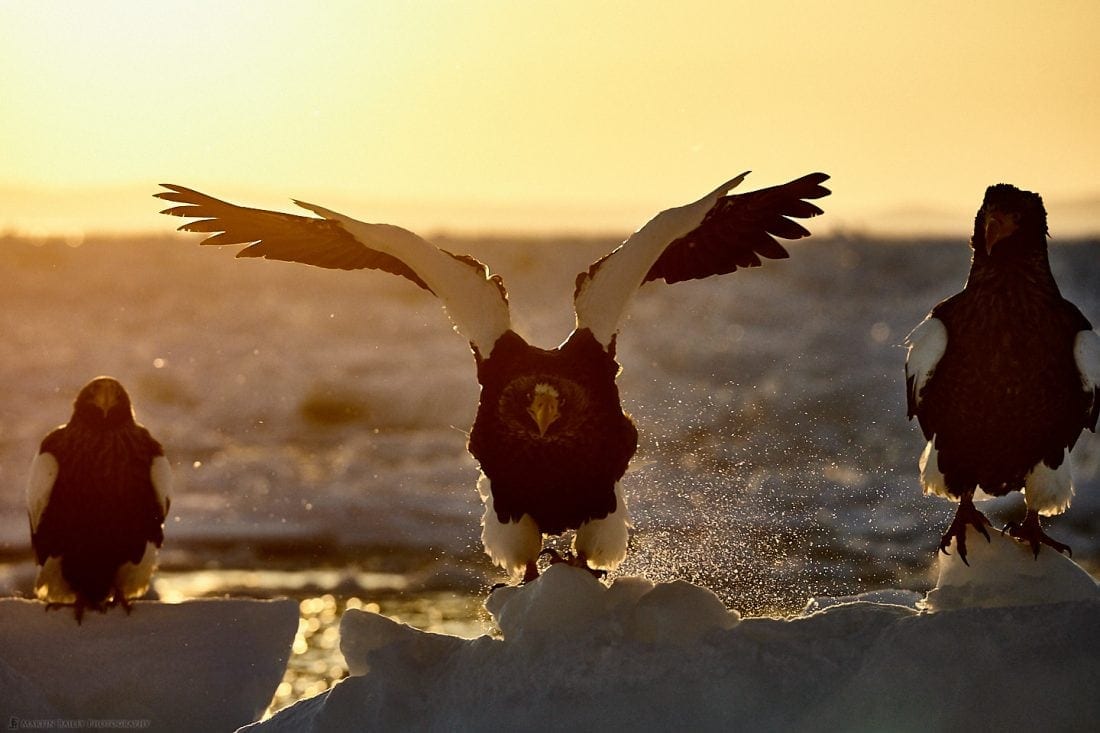
Having photographed the subjects on this trip so many times, it takes a lot to impress my wife when I get home, but she was impressed with this shot, as it’s something pretty different to what I usually come home with, and that feels good. My settings for this were ISO 1600 for a 1/1000 of a second at f/10, and a focal length of 400 mm.
Fishing in Dawn’s Warm Glow
The following morning, once again, I got lots of great shots, although the increasing number of seagulls and crows made it more difficult than usual. Before we finished our third and final trip out to shoot the eagles though, I asked the skipper to throw some fish into the sea in the open water, rather than onto the ice, so that we could get some photos like this one, with the
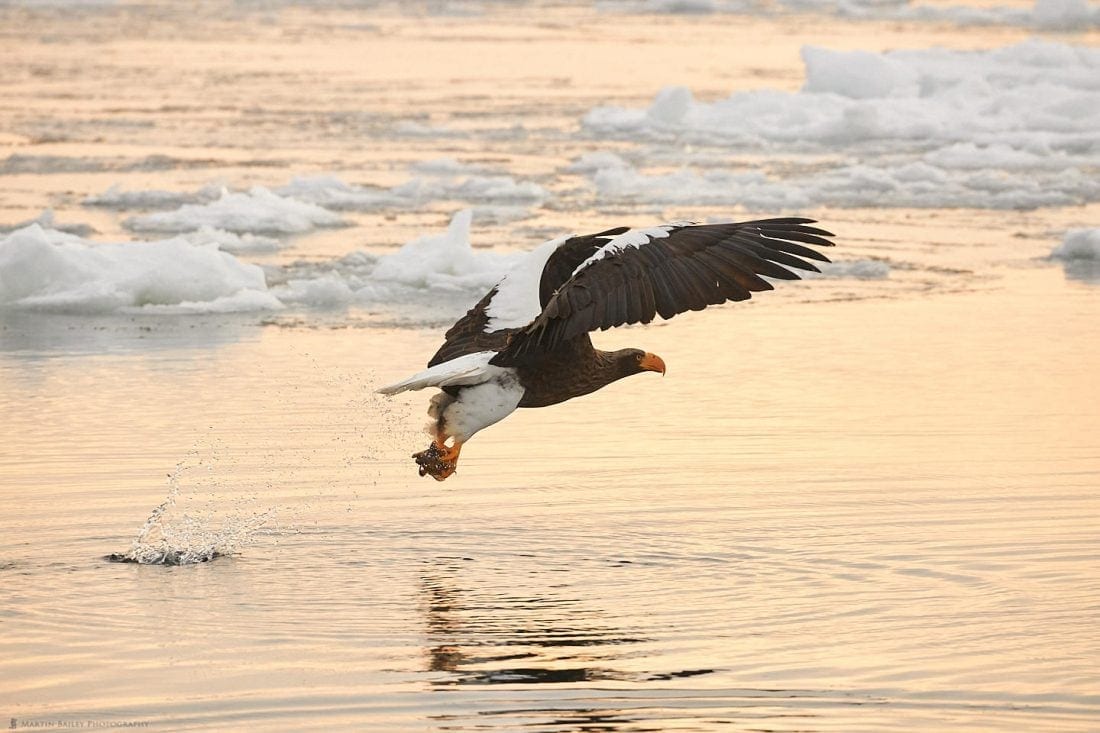
I really like that we have the warm glow of the dawn sky reflecting in the water in this photograph, as that makes up for the fact that we had to shoot back towards the sun a little. To ensure that the eagle was bright against the bright background, I actually shot this at ISO 4000, with a shutter speed of 1/1600 of a second at f/10. I was also very happy that the EOS R continued to perform well, autofocussing admirably against this contrasty water and ice. We did our usual drive around the base of the Shiretoko
Canon EOS R
Having completed all three of my Japan Winter Tours this year shooting almost exclusively with the new EOS R, Canon’s first full frame sensor mirrorless camera, I would just like to relay that I continued to be very happy with this camera, having now shot a total of around 16,000 images with it. There was the problem of the viewfinder fogging up, that I talked about in my review back in Episode 650, but other than that, it has way surpassed my expectations and even my hopes.
This doesn’t mean that my 5Ds R bodies are all of a sudden bad cameras, but I have instantly learned to appreciate the size and weight of the EOS R, and I’m now considering selling one of my two 5Ds R bodies, and keeping the funds on my point card at my local camera store, as I wait for the 5Ds R Mark II, which is rumored to also be coming along with the R Mount, and therefore obviously also a mirrorless camera. Although there have been plenty of people giving the EOS R a bad rap, personally, I’m incredibly pleased that I waited for Canon to finally release a full frame mirrorless camera, and I am really looking forward to being able to continue to use all of my beautiful Canon lenses moving forward.
Participant Comments
Before we wrap up this final travelogue episode for my 2019 winter season, I do of course have our final round of participant comments to play you from the bus on the final morning of the tour, as we headed towards the airport to fly back to Tokyo and disband.
[Please listen with the audio player at the top of this post to hear what each participant had to say about the trip.]
It was lovely, as usual, to hear the group again, now more than three weeks after the tour finished. Thanks to everyone for your wonderful comments!
Japan Winter Wildlife Tours 2020
OK, so we’ll wrap it up for now, but please do note that although Tour #1 has now sold out, we do still have some places open on the 2020 Japan Winter Wildlife Tour #2, so if you might be interested, please check that out here.

Show Notes
Michelle’s YouTube Channel: https://www.youtube.com/channel/UC4mSMZwzAoNX_XmJ2YPP2Tw/videos
See details of the 2020 Japan Winter Wildlife Tours here: https://mbp.ac/ww2020
Details of all available Tours & Workshops are here: https://mbp.ac/workshops
Audio
Subscribe in iTunes to get Podcasts delivered automatically to your computer.
Download this Podcast as an MP3 with Chapters.
Visit this page for help on how to view the images in MP3 files.


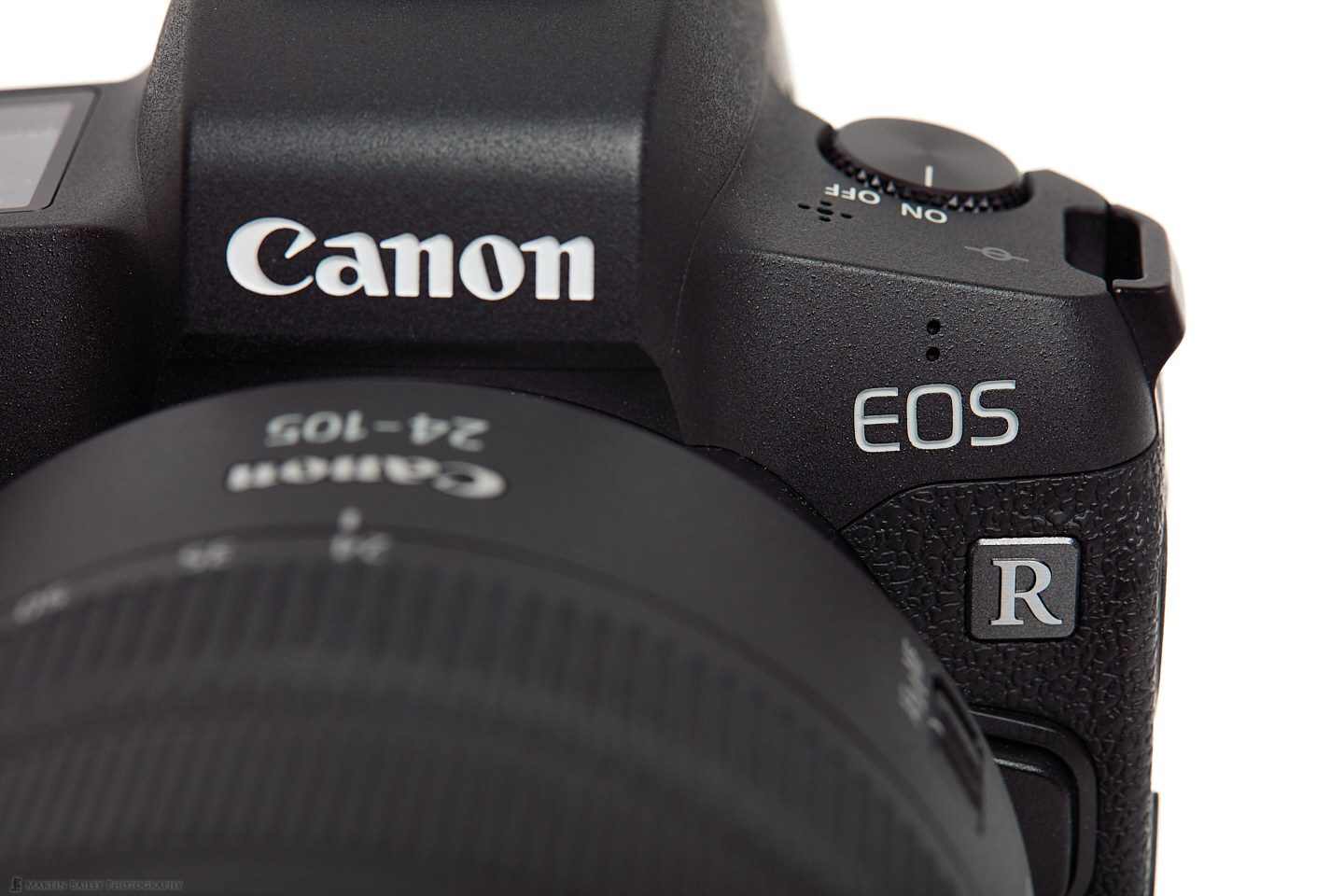

0 Comments